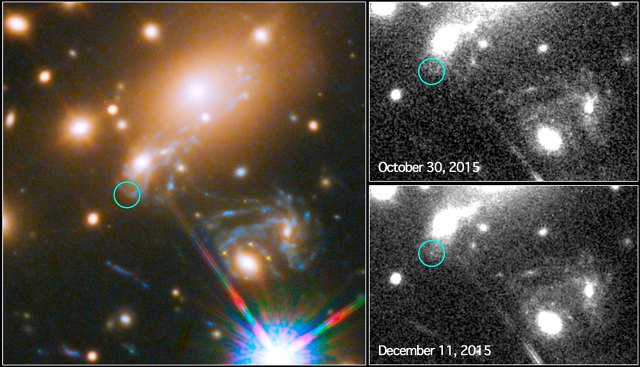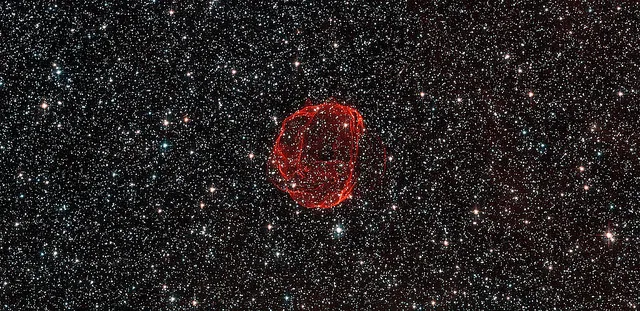We have trouble predicting whether or not it’s going to rain on a given day (which is understandable, because meteorology is hard), so how did astronomers, for the first time, predict when a star—much further up in the sky than clouds—was going to explode so they could be watching? Well, technically, they didn’t, but that doesn’t make its predicted appearance any less impressive.
The exploding star in question, the supernova Refsdal, actually happened long ago, but if you’re familiar with peering into the depths of outer space, you already know that anything we see from Earth happened a long time ago. Over the vast reaches of the Universe, light travels fairly slowly.
However, in the case of Refsdal, this isn’t even the first time its explosion has been seen from Earth. The supernova was previously recorded in 2014, when strong gravitational forces exerted on the traveling light by another galaxy caused it to show up as four distinct images known as an Einstein Cross. Using these images, astronomers were able to calculate where and when the supernova would reappear as its light made its way to Earth after taking a different, gravity-shaped path through space.

This image composite shows the search for the supernova, nicknamed Refsdal, using the NASA/ESA Hubble Space Telescope. The image to the left shows a part of the the deep field observation of the galaxy cluster MACS J1149.5+2223 from the Frontier Fields programme. The circle indicates the predicted position of the newest appearance of the supernova. To the lower right the Einstein cross event from late 2014 is visible. The image on the top right shows observations by Hubble from October 2015, taken at the beginning of observation programme to detect the newest appearance of the supernova. The image on the lower right shows the discovery of the Refsdal Supernova on 11 December 2015, as predicted by several different models.
So while a star’s explosion wasn’t predicted ahead of time (it’s way too late for that in Refsdal’s case), the calculations used to predict the appearance of light from the supernova provide insight into our understanding of mass and dark matter in space. The Hubble Space Telescope has been watching the area since October, and Refsdal made its appearance on December 11—right within the window astronomers had anticipated.
A news release from ESA explained:
“Hubble has showcased the modern scientific method at its best,” comments Patrick Kelly, lead author of the discovery and re-appearance papers and co-author of the modelling comparison paper from the University of California Berkeley, USA. “Testing predictions through observations provides powerful means of improving our understanding of the cosmos.”
The detection of Refsdal’s reappearance served as a unique opportunity for astronomers to test their models of how mass—especially that of mysterious dark matter—is distributed within this galaxy cluster. Astronomers are now eager to see what other surprises the ongoing Hubble Frontier Fields programme will bring to light.
(via Gizmodo, featured image via NASA Goddard Space Flight Center)
—Please make note of The Mary Sue’s general comment policy.—
Do you follow The Mary Sue on Twitter, Facebook, Tumblr, Pinterest, & Google +?









Published: Dec 17, 2015 10:42 am